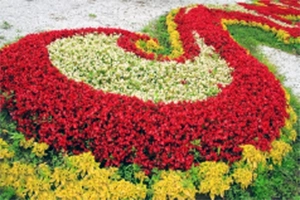 I have waited, with great anticipation, to plant my annual beds and the time is finally here. First task on my to-do list is to install my annual color at my home and at all the properties that my company maintains. As you read this you may be thinking, “Whoa, she’s a little late! I planted my color weeks and weeks ago.” Many people suffering from spring fever are tempted by big box stores and other garden centers when they display their vibrant annuals too early. As a professional landscape contractor, I refrain from planting seasonal color until after the frost free date. The frost free date is when you can safely plant your annuals and not have to worry about temperatures reaching below freezing. In North Georgia, we can safely say that no more frost will occur after April 15th. To understand my reasoning behind this planting date, let’s first look at what annual flowers are and then what frost is and how it is detrimental to annual plants.
I have waited, with great anticipation, to plant my annual beds and the time is finally here. First task on my to-do list is to install my annual color at my home and at all the properties that my company maintains. As you read this you may be thinking, “Whoa, she’s a little late! I planted my color weeks and weeks ago.” Many people suffering from spring fever are tempted by big box stores and other garden centers when they display their vibrant annuals too early. As a professional landscape contractor, I refrain from planting seasonal color until after the frost free date. The frost free date is when you can safely plant your annuals and not have to worry about temperatures reaching below freezing. In North Georgia, we can safely say that no more frost will occur after April 15th. To understand my reasoning behind this planting date, let’s first look at what annual flowers are and then what frost is and how it is detrimental to annual plants.
Annuals are exactly as the name sounds: plants that live their whole life cycle in one annual growing period. Although these flowering blossoms are not perennial and will only be around a short time, the blooms of many annuals deliver a vivid punch which can brighten up a garden or outdoor landscape design. They are generally used to enhance or direct attention to an area, or to fill in an area as the other plants are developing such as in a shrub border or perennial bed. Unless, you are installing a cool season annual, such as pansy or snapdragon, our summer annuals are too tender to withstand low night temperatures and frost.
 Frost develops in much the same way as dew forms. Frost usually forms when a surface cools through loss of infrared radiation to a temperature which is colder than the dew point of the air next to the surface, and the temperature of that surface is below freezing (32 deg F, or 0 deg. C). The source of this moisture is water vapor contained in the air. The heaviest coatings of frost usually do not occur at the coldest temperatures because very cold air cannot hold very much water vapor. Instead, thick deposits of frost usually occur when the air temperature is close to 32 deg. F (0 deg. C).
Frost develops in much the same way as dew forms. Frost usually forms when a surface cools through loss of infrared radiation to a temperature which is colder than the dew point of the air next to the surface, and the temperature of that surface is below freezing (32 deg F, or 0 deg. C). The source of this moisture is water vapor contained in the air. The heaviest coatings of frost usually do not occur at the coldest temperatures because very cold air cannot hold very much water vapor. Instead, thick deposits of frost usually occur when the air temperature is close to 32 deg. F (0 deg. C).
So how does this all affect our tender annuals? Frost causes the water in plant cells to freeze, as water freezes it expands and thus damages the cell wall. Frost-damaged plants are easy to spot; their growth becomes limp, blackened and distorted. The leaves of tender plants take on a translucent appearance. Frost problems are often made worse where plants face the morning sun, as this causes them to defrost quickly, rupturing their cell walls. Once damaged it is difficult for a plant to recover, if at all. The simplest thing to do is to prevent the damage all together and don’t get tempted to plant your annuals early.



Comments (0)
Thanks for your comment!
Thanks for your feedback! Your comments have been successfully submitted! Please note, all comments require admin approval prior to display.
Error submitting comment!
There is a problem with your comment, please see below and try again.